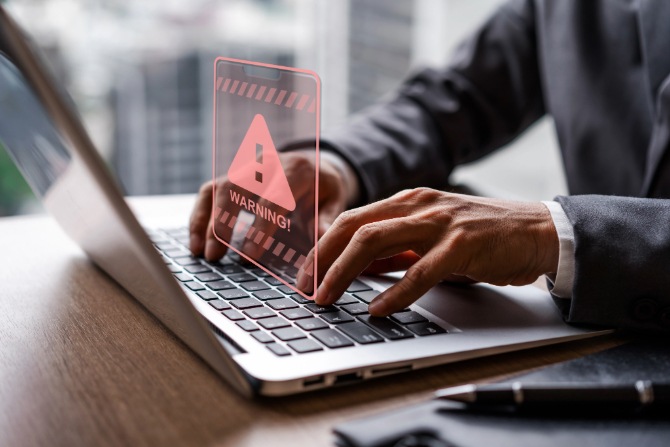
What is Malware?
Malware is malicious software that is purposefully designed to cause harm to a device. That’s the simplest definition, however, to truly understand a malware meaning, it is important to state that “malware” is an umbrella term used to describe a wide range of malicious software that operate in different ways.
As such, depending on how they function, each specific type of malware might be capable of performing different actions. For those wondering “What does malware do,” the answer is that these programs are capable of performing a wide range of malicious activities. These might include:
- Stealing sensitive information or private details, such as financial data, personal communications, login credentials, or even things like healthcare records and personal identification information.
- Disrupting a device’s operations and functionality, rendering them useless—in these cases, the attackers often demand a ransom.
- Destroying network infrastructure.
- Assuming control of a device to launch other attacks—such as a denial-of-service attack—or cryptomining programs.
- Monitoring a user’s online activity or device use.
- Compromising stored data.
All of this presents significant risks for individual and corporate users. For example, cybercriminals may use the data gained from a malware attack to steal money, leak confidential information, compromise a business’s network, or even perpetrate identity theft.
How does Malware spread?
Malware can infect devices in many different ways This includes spam email attachments, infected links, fraudulent software, USBs, apps, ads, or SMS. Regardless of the delivery method, malware can wreak havoc on devices and leave users vulnerable to the theft of sensitive information.
Types of Malware
Learning about what does malware mean and what these programs do is just one step in understanding how to safeguard against attacks. There are, in fact, different types of malware and it is important to learn the differences between them. Malware can behave in many different ways. Here are some of the most common types of malware:
1. Worms
2. Adware
3. Spyware
4. Virus
5. Bots
6. Ransomware
7. Trojan
8. Fileless Malware
Worms
Worms are a type of malware that replicate across different systems without infecting other objects on the same system. They may spread across networks by exploiting each device’s vulnerabilities. Like other malware, worms may damage devices by using up bandwidth and delivering payloads of harmful codes.
Adware
Adware requires a specific malware definition: these programs are illegitimate advertisements that typically present as pop-up windows when users unknowingly perform a specific action. These software collate data on device usage to provide targeted ads. Although these are not always dangerous, adware can contain malicious elements, such as Trojan horses and spyware.
Spyware
Spyware does not specifically require a technical malware definition because it is a catch-all term for a range of programs, including adware, riskware, keyloggers, and Trojans. These are malicious software that are usually installed on devices without the user’s knowledge and transmit certain information to a third party. Spyware can monitor all activity on a device, including online activity and what keys are pressed, which hackers can then use to harvest personal and financial data.
Virus
A virus is a type of malware that is able to self-replicate and spread throughout a device’s system. These are often delivered as an email attachment containing the malicious code—once the file is opened, the device is infected and its operation is compromised.
Bots
Bots are a form of malware designed to automatically perform specific operations. Although some are used for legitimate purposes—such as crawling websites for content to perform indexing for search engines—they can be used maliciously. For example, a hacker may use bots to scrape and harvest personal data so that cybercriminals may exploit the information for financial gain.
Ransomware
Ransomware is popular among cybercriminals because of the potential for immediate financial gain. This particular type of malware encrypts the files on a device, rendering it unusual. Victims then receive a message informing them that they need to pay a ransom (often in cryptocurrency) to get a key to restore the files and regain access to their devices. However, experts suggest that a ransom should never be paid because the attacker often disappears after receiving the money, leaving the victim with an unusable device.
Trojan
A Trojan horse, or Trojan for short, is a malicious software that disguises itself as an ordinary file but surreptitiously carries out attacks on a device. In many cases, users unwittingly download a Trojan without realizing they are installing malware and allowing it to steal data, spy, or launch another type of attack. There are different types of Trojans, including droppers that secretly install malicious code; downloaders that install new malicious programs; spies that track activity; banking trojans that mimic legitimate apps to steal financial information; and backdoor trojans that exploit vulnerabilities to take over a device.
Fileless Malware
These are a particularly insidious form of malicious software. Technically, these rely on a device’s memory instead of files stored on a hard drive and use legitimate programs to launch an attack. As such, they are far more difficult to detect than other malware—they leave no footprint because there are no files left to scan and no processes to detect.
How to Detect a Malware Infection
Users who notice a computer, mobile, or tablet displaying unusual behavior should immediately be suspicious of a malware attack. Although most malware is unobtrusive and may not be immediately detected by users, there are certain signs to look out for. Any of the following behaviors may indicate a malware infection:
- The device is operating slower than normal, and processes are taking a longer time to execute
- New apps or programs have appeared without the user downloading them
- Apps or programs keep crashing for no reason
- A phone’s data usage or bill has increased with no explanation
- Pop-ups appear when browsers are closed
- The phone’s battery drains quickly
- The device overheats
- Browsers redirect users to a different site
- The appearance of infection warnings, often with suggested solutions for purchase
Tips for Malware Removal
Users who believe their devices have been infected should take immediate action. Malware removal is the priority, of course, but there are other steps that can help mitigate the fallout of an attack, including:
- Downloading and installing security software
- Running an on-demand scan to detect and remove the malware—this may involve deleting or quarantining any suspicious files
- Disconnecting from the internet to prevent further harm
- Rebooting an infected computer or laptop in “Safe Mode”
- Deleting any temporary files with “Disk Clean up”
- Changing any passwords or login credentials that may have been compromised
- Updating the operating system, browsers, and all software
- Rescanning the computer to check for further threats
10 Tips for Malware Protection
As malware becomes more advanced, and with so much of our personal data now being stored online, the threat of a malware attack that steals ou information for nefarious purposes has never been more real or dangerous. For this reason, learning the basics of malware protection is essential. Here are several expert-recommended tips for safeguarding devices:
- Use anti-virus protection: Use robust endpoint security solutions, which can automatically scan devices to find and neutralize threats.
- Install anti-virus software on all devices: Using these programmes on computers is standard, but tablets and phones are just as susceptible to a malware attack, so it is important to protect these, too.
- Run regular checks: Use the security software to regularly run checks to stay ahead of any potential threats.
- Only download apps from trusted sites: Enhance malware protection by only downloading apps, software, or media files from trusted sites and app stores like Google Play or the Apple App Store. This lowers the risk of downloading fraudulent software that may be infected with malware.
- Check developer descriptions and user: Malware-infected software can sometimes appear on reputable app stores and sites. For this reason, always read about the developer to verify that they are reputable. In addition, hackers sometimes use forged reviews to entice users to download malware—quickly browse user reviews for any software or app before downloading it and look for a mix of reviews that flag both good and bad points.
- Check the number of downloads: Popular apps with millions of downloads are likely legitimate and fine to download—but apps that do not have a large number of downloads should be handled with care.
- Check the requested permissions: Look at what permissions an app or software wants—be wary of those that request permissions that do not seem necessary for optimal functionality.
- Do not click on unverified links: Avoid clicking unverified links in spam emails, messages, or suspicious websites—these may be phishing links or the initiation of a malware attack.
- Regularly update operating systems and apps: This is essential for malware protection as it installs the latest security patches that developers release, helping to safeguard devices and data. Hackers can exploit out-of-date software to launch a malware attack.
- Avoid using free Wifi: It is easy for hackers to steal personal data through unsecured public wifi networks. If you must use free wifi, protect devices and data with a VPN connection like Kaspersky VPN Secure Connection to encrypt data and try not to make any e-commerce or banking transactions.
Kaspersky received nine AV-TEST awards for the best performance, protection, and usability for a corporate endpoint security product in 2024. In all tests, Kaspersky products showed outstanding performance, protection, and usability for home and businesses.
Related Articles and Links:
How to remove malware from a PC or MAC
How to detect and avoid malware on Android devices
The biggest ransomware attacks
Recommended products:

